2018 Project Grant
North Dakota State University, Fargo, ND
Characterization of Trichothecene Mycotoxin Development during the Malting of Fusarium Infected Barley and other Grains
Trichothecene mycotoxins, such as deoxynivalenol (DON), as well as, zearalenone (ZEA), ergot alkaloids, alternariol, fumonisins and ochratoxin have all been detected in beer (Scott 1996; Bauer et al. 2016). DON has presented the largest challenge to maltsters and brewers. While grain with lower DON levels can often be used as DON is lost during steeping, there are occasionally samples that exhibit aberrant behavior, where DON levels increase significantly during malting. This situation was last extensively seen during the 2016 crop year, with samples from the upper Midwest and Prairie provinces of Canada. It is difficult to predict, but maltsters have speculated it may relate to internal vs external infection with Fusariums. While there is no published research to directly support this, it would seem that earlier infections could result in more extensive colonization of the grain, when compared to late infection. Somewhat supporting this is the dramatic increase of DON levels that has been observed during the malting of wheat
and rye (Jin, et al., 2018; Paul Schwarz, unpublished). This is of interest as both wheat and rye flower after heading, while barley flowers in the boot stage. Rye is also open-pollenated and flowers for an extended period of time. These differences in flowering pattern could lead to more extensive colonization in wheat and rye.
Project Objectives
Objectives of the project are to investigate the causes of the differential in production of DON
and other mycotoxins that are observed during the malting of Fusarium Head Blight (FHB) infected
small grains.
Factors to be evaluated include:
- The distribution of Fusarium spp. within the kernel.
- Fusarium viability as influenced by infection parameters and grain storage.
- Fusarium growth and mycotoxin production during malting, as influenced by infection parameters and grain storage.
Project Final Report
As a sponsorship benefit, a final report will be available in the fall of 2019.
